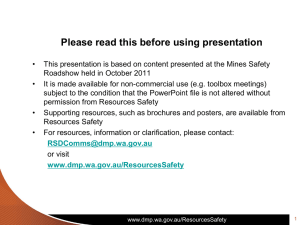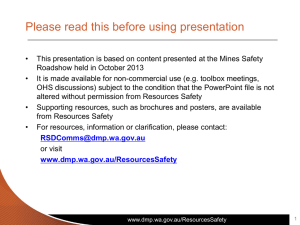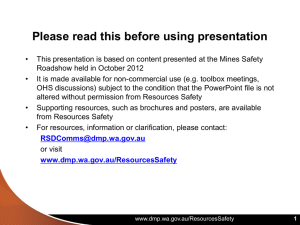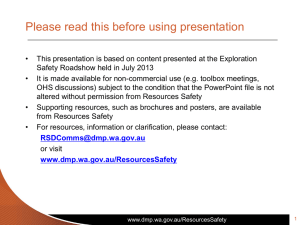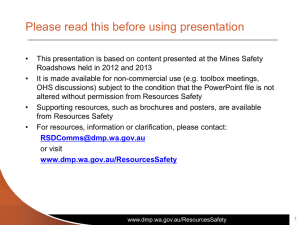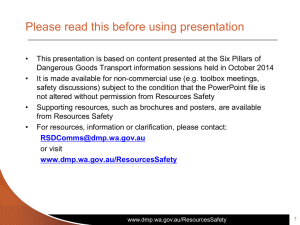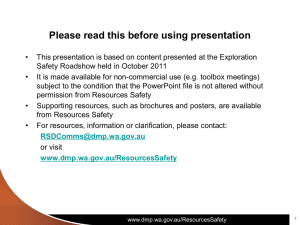Electrical Hazard Awareness Powerpoint Presentation
advertisement
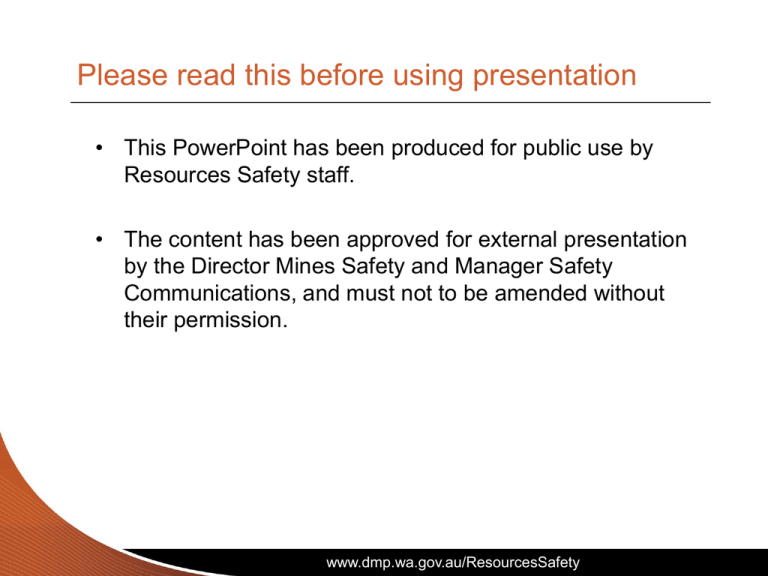
Please read this before using presentation • This PowerPoint has been produced for public use by Resources Safety staff. • The content has been approved for external presentation by the Director Mines Safety and Manager Safety Communications, and must not to be amended without their permission. www.dmp.wa.gov.au/ResourcesSafety Electrical hazard awareness www.dmp.wa.gov.au/ResourcesSafety What does hazard mean? Hazard means: • any potential or actual threat to the wellbeing of people, machinery or environment Electrical hazard safety means: • taking precautions to identify and control electrical hazards www.dmp.wa.gov.au/ResourcesSafety Why know about it? Because failing to take the necessary precautions can lead to: • injury or death • fire or property damage www.dmp.wa.gov.au/ResourcesSafety What are the safety priorities? Electrical hazards exist in almost every workplace. Common causes of electrocution are: • making contact with overhead wires • undertaking maintenance on live equipment • working with damaged electrical equipment, such as extension leads, plugs and sockets • using equipment affected by rain or water ingress www.dmp.wa.gov.au/ResourcesSafety How do you respond to electrical incidents? If you come across a person receiving an electric shock: • if possible, disconnect the electrical supply (switch?) • assess the situation – never put yourself at risk • take precautions to protect yourself and anyone else in the vicinity • apply the first aid principles (e.g. DRSABCD) • assess the injuries and move the casualty to a safe area if required • administer first aid if trained • seek urgent medical attention www.dmp.wa.gov.au/ResourcesSafety Do you want to be a victim? You could be the victim if you: • don’t follow proper procedures around electricity • use electrical equipment improperly • use faulty electrical equipment www.dmp.wa.gov.au/ResourcesSafety What are the types of injuries? • Burns • Shocks • Falls KEEP SAFE KNOW HOW TO CONTROL ELECTRICAL HAZARDS www.dmp.wa.gov.au/ResourcesSafety What are the levels of effect of current? AC current (mA) 1 2-9 Effect on human body Slight tingling sensation Small shock 10-24 Muscles contract causing you to freeze 25-74 Respiratory muscles can become paralysed; pain; exit burns often visible 75-300 Usually fatal; ventricular fibrillation; entry & exit wounds visible >300 Death almost certain; if survive will have badly burnt organs and probably require amputations www.dmp.wa.gov.au/ResourcesSafety What should you do in an electrical emergency? For low voltage electricity >50 V AC and 110 V DC • remove the source of electricity supply • commence CPR if trained • call the emergency number on site For high voltage electricity >1000 V • call the emergency number for your site • don’t go near the casualty • don’t touch the casualty or try to free them with anything www.dmp.wa.gov.au/ResourcesSafety Should you report electrical incidents? • Electricity is invisible – this in itself makes it dangerous • It has great potential to seriously injure or kill • The company has a duty of care to its employees and contractors • Everyone is exposed to electrical hazards, not just electricians • Report all electrical shocks and near misses ALL EMPLOYEES CAN BE EXPOSED TO ELECTRICAL HAZARDS. THEY SHOULD RECEIVE ELECTRICAL HAZARD TRAINING AT THE COMMENCEMENT OF THEIR EMPLOYMENT AND REGULAR REFRESHER TRAINING. www.dmp.wa.gov.au/ResourcesSafety Can you protect yourself from electricity? • Don’t wear metal objects • Turn power off • Wear appropriate clothing • Don’t touch live parts • Don’t install or repair electrical equipment • Use qualified personnel • Clean and dry leads and plugs before use • Use PPE www.dmp.wa.gov.au/ResourcesSafety What are other safety measures? • Heed warning signs • Use the right equipment • Study the operation manual • Take care of extension leads • Use only approved extension lamps • Don’t pull on leads • Use residual current devices – RCDs • Use the proper fuses and circuit breakers www.dmp.wa.gov.au/ResourcesSafety Regular safety inspections are a part of YOUR job... • Electrical equipment should be checked each time before use for defects • If not tagged or the tag is out of date then report it and place it out of service www.dmp.wa.gov.au/ResourcesSafety Should you be aware of powerlines? • Do you know if there are overhead powerlines on your site? • Do you know where they are located? • Do you know what the safe work clearance is? • Strict regulations are laid down to cover any work that may have to be performed close to overhead powerlines www.dmp.wa.gov.au/ResourcesSafety What is a powerline corridor? MSI Regulation 5.28 defines a powerline corridor as the area under any overhead powerline that has not been properly isolated, and 10 metres either side of the powerline. • It is essential that these areas are respected. They are there for the safety of everyone • Do not store equipment, machinery, buildings or structures in powerline corridors • Do not construct, fabricate or maintain structures, buildings, machinery or equipment in powerline corridors LOOK UP AND LIVE www.dmp.wa.gov.au/ResourcesSafety Can a powerline be approached safely? Up to and including to 33 kV • 2.3 m when passing underneath and 3 m when passing to the side Above 33 kV • 4 m when passing underneath and 6 m when passing to the side www.dmp.wa.gov.au/ResourcesSafety Who can access substations? • Only trained and authorised personnel may enter and work inside a substation • To enter a substation you must complete the substation entry training • Access is restricted for any cabinet with exposed energized parts ALL ELECTRICAL WORK MUST TO BE RECORDED AND ENTERED INTO THE ELECTRICAL MINES RECORD BOOK, AND THE ELECTRICAL SUPERVISOR INFORMED www.dmp.wa.gov.au/ResourcesSafety What are electric shock hazards? • Arc welding can and has killed people in high risk environments • Everyone involved needs to better understand the hazards, adopt sound practice and use appropriate safety devices • Study and adhere to the Code of Practice: WTIA Tech Note 7-04 • Use safety devices such as manual trigger switches and voltage reducing devices (VRDs) • Under adverse conditions, strive to improve control measures (e.g. presence of moisture as sweat or rain) www.dmp.wa.gov.au/ResourcesSafety A welding incident… • Assistant hands welder a metal object. Resultant current is 35 mA I = V/R = 67/1900 = 35 mA Result = Assistant survived but welder died www.dmp.wa.gov.au/ResourcesSafety Do you have permission to dig? Be aware of the potential hazard from buried electrical cables for the following activities: • excavation • drilling • trenching • levelling • digging • driving of stakes or pegs Do not commence excavation work near buried cables unless a permit has been issued by an authorised person Do you know what precautionary measures need to be taken? www.dmp.wa.gov.au/ResourcesSafety What risk assessment?! www.dmp.wa.gov.au/ResourcesSafety Is this a problem? www.dmp.wa.gov.au/ResourcesSafety The key messages are… • The risk of electric shock from correctly installed and maintained power sources is negligible, provided that sensible precautions are taken by the operator and correct work procedures are followed • Ensure that the right person is carrying out electrical work – licensed versus competent • Electricity is essential but, improperly used, it can be DEADLY! To STAY ALIVE, you have to STAY ALERT www.dmp.wa.gov.au/ResourcesSafety
